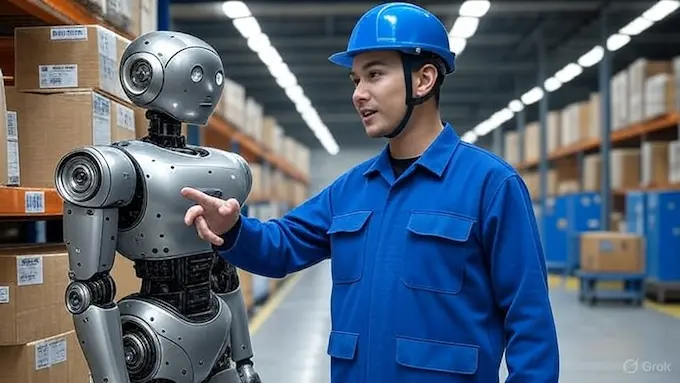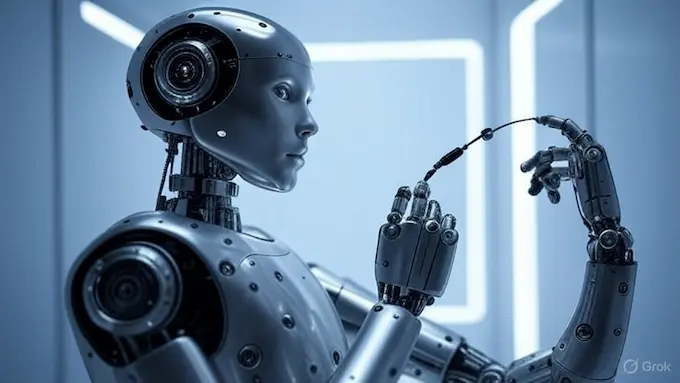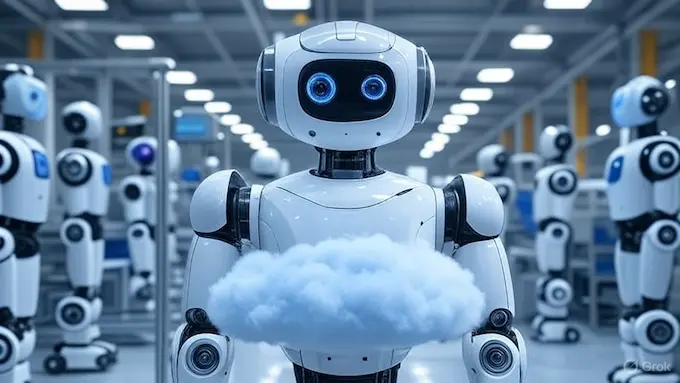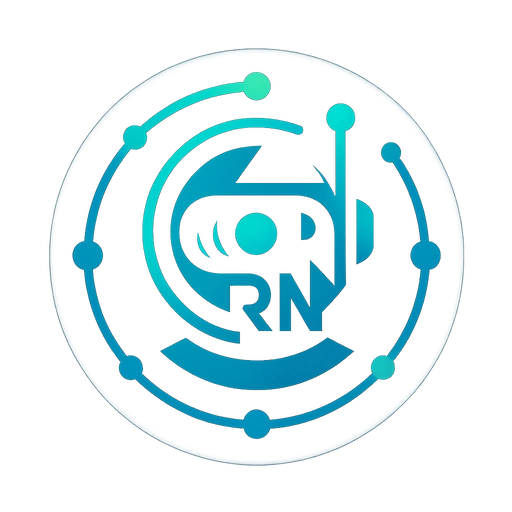Table of Contents
Introduction: A New Era for Intelligent Machines
For decades, robotics has been defined by precision and repetition. Traditional robots are masters of predefined tasks, executing commands with flawless accuracy within controlled environments like factory assembly lines. However, their intelligence has been rigid, built on explicit programming and rule-based systems. They operate based on what they are told to do, struggling to adapt to novel situations or understand ambiguous human instructions.
This paradigm is undergoing a revolutionary shift, catalyzed by the rise of Generative AI. Unlike conventional AI, which primarily analyzes or classifies existing data, generative models create new, original content. This includes everything from text and images to complex simulations and physical action plans. By integrating foundational models like Large Language Models (LLMs) and diffusion models, we are moving from simply programming robots to training them—enabling them to learn, reason, and interact with the world in a fundamentally more dynamic and intuitive way.
This fusion is not merely an incremental upgrade; it represents the dawn of a new era. It promises to build smarter, more adaptive machines that can understand natural language, generate novel solutions to physical problems, and collaborate with humans more seamlessly than ever before. This article explores the core applications of this synergy, the significant hurdles we face, and the collaborative future it heralds.
Walk into a modern factory or warehouse and you’ll see robots everywhere: arms that weld, carts that navigate aisles, machines that move with precision but not much imagination. These robots excel at repetition. They follow rules, execute pre-programmed tasks, and rarely surprise anyone.
Generative AI in robotics changes that picture. Instead of scripting every action, engineers can now equip robots with models that can “imagine” solutions. A robot no longer needs an exhaustive dataset of every possible box shape or shelf layout. With generative AI, it can synthesize new examples, simulate scenarios, and adapt on the fly. This is more than incremental improvement. It’s a paradigm shift, moving from deterministic control toward adaptive, data-driven intelligence.
For decades, robotics has relied on handcrafted control and massive labeled datasets. Generative models, from diffusion systems to large language models (LLMs), upend this approach. They let robots reason beyond what they’ve explicitly seen. It’s as if we’ve given them not just eyes and arms, but a spark of imagination.
2. Core Applications Of Generative AI In Robotics
2.1 Enhancing Robot Learning And Manipulation
Generative AI is being applied across the entire robotics lifecycle, from initial design to real-world deployment and interaction. A robot’s ability to act is fundamentally limited by its ability to perceive. Training robust perception models requires massive, diverse, and perfectly labeled datasets—a major bottleneck that is expensive and often dangerous to acquire in the real world.
Generative AI provides a powerful solution: synthetic data. Using techniques like Generative Adversarial Networks (GANs) and diffusion models, developers can create limitless photorealistic training data. This data can include rare “edge cases” that a robot might seldom encounter in reality, such as specific weather conditions, unusual obstacles, or equipment malfunctions.
| Aspect | Traditional AI in Robotics | Generative AI in Robotics |
|---|---|---|
| Learning Method | Rule-based, dataset-driven | Creates synthetic data, adapts beyond training |
| Flexibility | Limited to programmed scenarios | Generalizes to new and unseen situations |
| Human Interaction | Structured commands only | Natural language understanding with LLMs |
| Simulation Use | Basic environment modeling | Rich, diverse, adaptive simulations |
| Scalability | Manual reprogramming required | Continuous and autonomous learning |
Comparison of core aspects between traditional, rule-based robotics approaches and modern generative AI driven methods.
Authentic Data Point: NVIDIA’s Isaac Sim™ platform leverages generative AI to create physically accurate, simulated environments. It can generate vast, automatically labeled datasets to train perception models for robots, significantly reducing the time and cost of real-world data collection and drastically improving the robot’s robustness in unpredictable settings.
A robot’s ability to act is fundamentally limited by its ability to perceive. Training robust perception models requires massive, diverse, and perfectly labeled datasets—a major bottleneck that is expensive and often dangerous to acquire in the real world.
Generative AI provides a powerful solution: synthetic data. Using techniques like Generative Adversarial Networks (GANs) and diffusion models, developers can create limitless photorealistic training data. This data can include rare “edge cases” that a robot might seldom encounter in reality, such as specific weather conditions, unusual obstacles, or equipment malfunctions.
Authentic Data Point: NVIDIA’s Isaac Sim™ platform leverages generative AI to create physically accurate, simulated environments. It can generate vast, automatically labeled datasets to train perception models for robots, significantly reducing the time and cost of real-world data collection and drastically improving the robot’s robustness in unpredictable settings.
A robot’s ability to act is fundamentally limited by its ability to perceive. Training robust perception models requires massive, diverse, and perfectly labeled datasets—a major bottleneck that is expensive and often dangerous to acquire in the real world.
Generative AI provides a powerful solution: synthetic data. Using techniques like Generative Adversarial Networks (GANs) and diffusion models, developers can create limitless photorealistic training data. This data can include rare “edge cases” that a robot might seldom encounter in reality, such as specific weather conditions, unusual obstacles, or equipment malfunctions.
Authentic Data Point: NVIDIA’s Isaac Sim™ platform leverages generative AI to create physically accurate, simulated environments. It can generate vast, automatically labeled datasets to train perception models for robots, significantly reducing the time and cost of real-world data collection and drastically improving the robot’s robustness in unpredictable settings.
Robot learning traditionally means feeding machines enormous amounts of real-world data. Generative AI reduces this burden by creating synthetic data. Imagine training a robotic gripper: instead of collecting thousands of physical trials, engineers can generate endless variations of objects, textures, and scenarios in simulation.
The benefits go beyond efficiency. Generative AI for robot learning allows systems to generalize. A robot that has only grasped cylinders and cubes can infer how to pick up a mug with a handle, or a crumpled bag. By predicting trajectories and simulating outcomes, it becomes less brittle in unfamiliar settings.

2.2 Improving Human-Robot Interaction
Human-robot interaction has long suffered from a communication gap. Robots interpret structured commands well, but stumble with natural human speech. Generative models, especially LLM robotics, bridge that gap.
The gap between human intent and robot action has long been a barrier to widespread adoption. Generative AI, particularly LLMs, is closing this gap by creating a natural language interface for robotics.
Instead of complex code or joystick commands, users can issue high-level instructions in plain English. For example, a command like, “Please get the healthy snack from the kitchen counter,” requires the robot to perform a complex sequence of actions:
- Interpret “healthy snack”: Identify which item among many qualifies.
- Navigate: Plan a path to the kitchen.
- Perceive: Locate the counter and the specific item.
- Manipulate: Execute the precise grasping motion required.
- Authentic Data Point: Google’s Robotics Transformer 2 (RT-2) is a visionary vision-language-action (VLA) model. By training on vast amounts of text and images from the web, RT-2 learns to connect concepts and translate them into direct robot actions. It can reason about and execute tasks it was never explicitly trained for, demonstrating an emergent capability for generalized problem-solving.
A worker can tell a robot, “Bring me the small blue box from the second shelf,” and the robot can parse the request, reason about context, and execute. Beyond logistics, this makes collaboration fluid in factories, hospitals, and homes. Robots become teammates instead of tools, able to respond to intent rather than rigid commands.

This generative AI human-robot interaction doesn’t just improve efficiency. It changes how we perceive robots: not as clunky machines, but as adaptive partners.
2.3 Streamlining Design And Simulation
Before a single bolt is tightened on a prototype, engineers rely on simulation. Generative AI takes this further. It can generate realistic environments, stress-test robotic systems under countless variations, and even propose optimized designs.Generative AI is also transforming how robots are physically conceived and built. Generative design is an iterative process where engineers input design goals and constraints (e.g., weight, material, strength requirements, cost) into an AI model. The model then explores thousands or even millions of design permutations, producing optimized shapes and structures that are often more efficient and lightweight than what a human could design alone.
This is particularly useful for creating custom end-effectors (grippers), robot limbs, and support structures that are perfectly tailored to their specific tasks, maximizing performance while minimizing material usage.

For example, generative models can suggest joint structures that balance strength with weight, or simulate how a mobile robot navigates environments it’s never physically encountered. This shortens development cycles and reduces costs, while opening creative possibilities engineers might not have considered.
2.4 Autonomous Task and Motion Planning
Beyond understanding commands, robots must generate the sequence of actions to fulfill them. Generative models can synthesize complex, multi-step plans and generate smooth, collision-free motion trajectories. Instead of relying on rigid, pre-calculated paths, a robot can generate a novel plan on the fly to navigate a cluttered room or manipulate an unfamiliar object. This allows robots to move from simply executing a program to demonstrating genuine problem-solving behavior.
3. Key Challenges And Ethical Considerations
Despite the immense potential, significant hurdles remain before generative AI-powered robots become commonplace.
3.1 Computational And Scalability Hurdles
Training large generative models is computationally expensive. Running them on embedded robotic hardware is even harder. Many current breakthroughs live in research labs with racks of GPUs, not on battery-powered machines navigating warehouses. Scaling down without losing intelligence is a core engineering challenge.The models powering this revolution, especially LLMs, are computationally massive. Training and even running inference on these models require significant processing power, typically from high-end GPUs or TPUs. Deploying these models onto resource-constrained, mobile robots with limited battery life is a major engineering challenge. The cost of cloud processing or the size of on-board hardware can be prohibitive for many applications.
3.2 Safety, Reliability, And Interpretability
Robots don’t just make recommendations, they act in the physical world. A generative AI system making opaque decisions can pose safety risks. How do we ensure a robot won’t misinterpret a command or take an unsafe trajectory? Interpretability remains one of the toughest problems. Engineers want not only performance but also transparency.While synthetic data is a powerful tool, a gap often exists between simulation and reality. A model that performs flawlessly in a clean, virtual environment may fail when faced with the subtle, unpredictable physics of the real world—like unexpected friction, sensor noise, or variations in lighting. Closing this sim-to-real gap requires creating even more realistic simulations and developing models that are inherently more robust to real-world variability.The creative, generative nature of these models is also a potential liability. An AI “hallucination”—where a model generates a factually incorrect or nonsensical output—can be catastrophic if it translates into an unsafe physical action by a powerful robot. Ensuring that a robot’s behavior remains predictable, reliable, and within strict safety boundaries is a non-negotiable requirement, especially in human-centric environments like homes, hospitals, and public spaces.
3.3 Data Privacy And Bias
Generative models learn from data, and data carries bias. If training sets underrepresent certain contexts, robots may inherit blind spots. Privacy is another concern. A robot deployed in hospitals or homes may capture sensitive information. Balancing utility with safeguards will be critical for responsible adoption.
4. The Future Of Generative AI In Robotics
4.1 Continuous Learning And Skill Acquisition
Future robots won’t just be pre-trained and deployed. They’ll keep learning. Imagine a household robot that improves every time it loads a dishwasher, sharing lessons across a network of similar machines. Generative AI enables this kind of continuous adaptation, pushing robots toward lifelong learning.

4.2 Simulation-To-Real Transfer
One of the biggest hurdles in robotics has always been the “sim-to-real gap.” A robot that performs flawlessly in simulation often fails in messy real-world conditions. Generative models help bridge this divide by creating richer, more realistic virtual experiences. The closer simulation gets to reality, the smoother the transfer of skills.
4.3 Integration With Other Technologies
Generative AI won’t exist in isolation. It will weave into digital twins, advanced vision-language models, and cloud robotics. A factory could maintain a living digital twin of its operations, where robots continuously test strategies in simulation before executing them in real life. The fusion of generative AI with these systems could unlock entirely new levels of efficiency and autonomy.
4.4 The Future of Generative AI in Robotics
| Application Area | Example Use Case | Benefits |
|---|---|---|
| Robot Learning | Grasping unseen objects | Faster training, adaptability |
| Human-Robot Interaction | Natural language command processing | Seamless teamwork in shared workspaces |
| Industrial Automation | Assembly line optimization | Reduced downtime, greater flexibility |
| Simulation & Design | Virtual prototyping and stress testing | Lower costs, faster development |
| Future Robotics | Continuous skill sharing across networks | Scalable and autonomous adaptability |
Examples of how generative AI is applied across robotics, from learning and design to automation and future adaptability.
The trajectory of this field points toward even deeper integration and more sophisticated capabilities.
Hyper-Personalization: Generative AI will allow robots to adapt their behavior to individual users. A companion robot could learn its owner’s specific routines and preferences, while an industrial robot could be quickly re-tasked for a new product line simply by being shown a video or given a description of the goal.
Multi-Modal Understanding: Future robots will be powered by models that learn from text, images, video, and physical interaction data simultaneously. This will enable a holistic understanding of their environment, allowing them to comprehend verbal commands, visual cues, and physical feedback all at once.
Self-Improving Systems: We can anticipate robots that use generative models to “imagine” the outcomes of their actions before performing them. They could run thousands of internal simulations to find the best strategy for a task or even generate their own training curricula to learn new skills autonomously.
5. A Collaborative Future
Generative AI in robotics is more than a technical breakthrough. It marks a cultural shift in how we design, deploy, and live alongside machines. Robots are no longer static tools. They’re becoming adaptive systems that learn, simulate, and collaborate.
Ultimately, the goal of integrating generative AI into robotics is not to replace humans but to augment our capabilities. By making robots more intuitive, adaptive, and easier to instruct, we are creating a new class of tools that can act as true collaborators. From assisting surgeons with generative motion plans to helping warehouse workers with intelligent lifting and sorting, these smarter machines will empower people to perform their jobs more safely and efficiently. The future is not one of humans versus machines, but of humans and machines working in a powerful, collaborative synergy to solve some of the world’s most pressing challenges.
The coming decade will test our ability to scale these models responsibly, to balance innovation with ethics, and to design robots we can trust. But the direction is clear. We’re moving into an age of intelligent automation, where machines don’t just repeat instructions. They imagine.
If you’re building in this space, now’s the time to experiment. Whether you’re designing industrial systems, healthcare assistants, or autonomous platforms, generative AI gives you a new lens for what robots can become. The future won’t be built by AI alone, or by humans alone. It will be a collaboration.
6. Conclusion: Architecting the Future of Intelligence
The integration of generative AI marks a pivotal moment for robotics, transitioning these machines from mere tools of execution into genuine partners in creation and problem-solving. By enabling robots to understand, adapt, and generate novel solutions, we are unlocking capabilities previously confined to science fiction. While the path forward requires navigating significant challenges in safety, computation, and reliability, the trajectory is clear. The ultimate promise is a future where robotic intelligence doesn’t replace human ingenuity but amplifies it, leading to breakthroughs in nearly every field of endeavor. We are not just building smarter machines; we are architecting the next frontier of collaboration between human and artificial though
Q1. How do generative models help robots adapt to new environments?
Generative AI for robot learning creates synthetic scenarios, making robots adaptable to unfamiliar settings without retraining from scratch.
Q2. What is the role of generative AI in manufacturing and logistics automation?
Generative AI applications in industrial automation help optimize workflows, improve flexibility, and reduce downtime in manufacturing and logistics.
Q3. How do generative models make human-robot communication more natural?
Through LLM robotics, machines understand natural language, enabling smooth generative AI human-robot interaction in workplaces and homes.
Q4. What are the ethical and safety concerns of using generative AI in robots?
Challenges of generative AI in robotics include safety risks, lack of interpretability, biases in training data, and privacy concerns.
Q5. What are the key differences between rule-based AI and generative AI for robots?
Generative AI vs traditional AI robotics: traditional systems follow fixed rules, while generative models invent solutions and generalize beyond training.
Q6. What new roles will generative AI unlock for robots in the next 5–10 years?
Future trends in generative AI robotics point toward robots as collaborative partners in healthcare, disaster response, and adaptive manufacturing.


